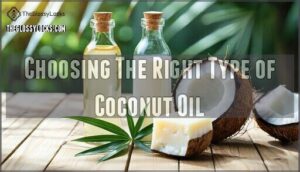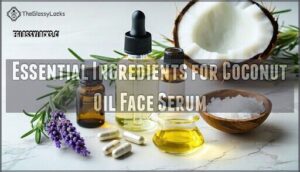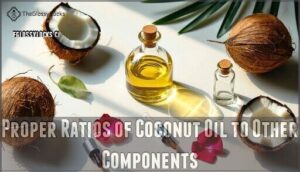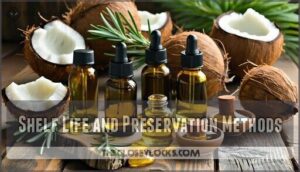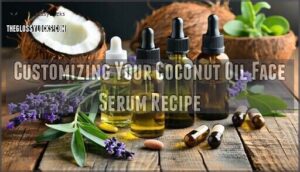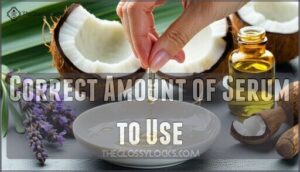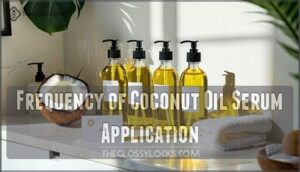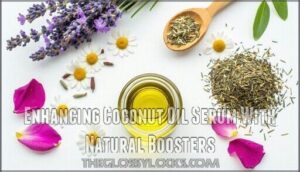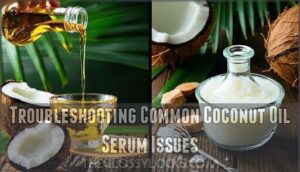This site is supported by our readers. We may earn a commission, at no cost to you, if you purchase through links.
 Creating your own coconut oil face serum is simpler than you’d think.
Creating your own coconut oil face serum is simpler than you’d think.
You’ll need 2-3 tablespoons of virgin coconut oil as your base, then blend it with lighter carrier oils like jojoba or rosehip seed oil to prevent that heavy, greasy feeling.
Add a few drops of essential oils that match your skin’s needs – tea tree for acne-prone skin, or lavender for sensitive types.
Don’t forget a small amount of vitamin E oil, which acts as your natural preservative and antioxidant powerhouse.
Mix everything in a clean glass bottle, and you’ve got a customized serum that rivals expensive store-bought versions.
The real magic happens when you learn which ratios work best for your unique skin chemistry.
Table Of Contents
- Key Takeaways
- Benefits of Coconut Oil in Face Serums
- Choosing The Right Type of Coconut Oil
- Essential Ingredients for Coconut Oil Face Serum
- Step-by-Step Guide to Making Coconut Oil Serum
- Customizing Your Coconut Oil Face Serum Recipe
- Application Techniques for Coconut Oil Face Serum
- Potential Side Effects and Precautions
- Comparing Homemade Vs. Store-Bought Coconut Serums
- Enhancing Coconut Oil Serum With Natural Boosters
- Troubleshooting Common Coconut Oil Serum Issues
- Frequently Asked Questions (FAQs)
- How do you make a DIY face serum?
- What is a DIY essential oil face serum?
- What are the best oils for homemade face serums?
- How do you use coconut oil in a face mask?
- What is the best homemade serum for face?
- What to mix with coconut oil for glowing skin?
- What is the best homemade face serum?
- Is coconut oil a good face serum?
- How to make your own anti-aging serum?
- What is the best oil for homemade face serum?
- Conclusion
Key Takeaways
- You’ll need just 2-3 tablespoons of virgin coconut oil as your base, then blend it with lighter carrier oils like jojoba or rosehip to prevent greasiness and customize for your skin type.
- Start with fractionated coconut oil if you’re acne-prone since it’s non-comedogenic, and always patch-test behind your ear for 24-48 hours before applying to your face.
- Add 3-5 drops of essential oils (tea tree for acne, lavender for sensitive skin) plus a few drops of vitamin E oil for antioxidant protection and natural preservation.
- Store your serum in dark glass bottles away from heat and light, and expect a 3-6 month shelf life – much shorter than commercial products but with complete control over ingredients.
Benefits of Coconut Oil in Face Serums
Coconut oil transforms your skincare routine with its impressive ability to lock in moisture while fighting bacteria that cause breakouts.
You’ll discover how this tropical powerhouse reduces inflammation, strengthens your skin’s natural barrier, and delivers antioxidant protection that keeps your complexion looking fresh and healthy.
Moisturizing Properties of Coconut Oil
Your skin craves that deep hydration, and coconut oil delivers like a champ!
Coconut oil transforms dry skin into a glowing, hydrated canvas that rivals expensive store-bought serums.
Thanks to its unique fatty acids structure, this natural emollient penetrates your skin barrier efficiently.
The hydration mechanism works by boosting lipid levels, creating a protective seal that locks moisture in for hours.
When you’re crafting your DIY face serum, coconut oil’s moisturizing power transforms dry skin into a supple, glowing canvas that’ll have you ditching expensive store-bought alternatives.
Antimicrobial Effects on Skin
Your DIY face serum’s antimicrobial properties pack a powerful punch against unwanted skin invaders. Coconut oil’s lauric acid benefits include fighting acne bacteria control while providing natural antiseptic properties for clearer skin.
Here’s what coconut oil tackles:
- Propionibacterium acnes (the main acne culprit)
- Surface bacteria causing breakouts
- Minor skin infections and irritations
- Wound healing support for faster recovery
This antimicrobial powerhouse makes your homemade serum a smart choice for skin infection prevention.
Antioxidant Protection for Facial Skin
Beyond fighting acne-causing bacteria, coconut oil acts as your skin’s personal bodyguard against free radical damage.
These unstable molecules from environmental stressors like pollution and UV rays can wreak havoc on your complexion.
Think of antioxidants in coconut oil as tiny shields protecting your cells.
The vitamin E and phenolic compounds work together in antioxidant synergy, neutralizing harmful molecules before they trigger premature aging.
This cellular regeneration boost helps repair existing sun damage while preventing future harm.
Your coconut oil serum delivers these protective benefits directly where you need them most.
The coconut oil benefits extend beyond surface hydration—they’re literally fighting aging at the molecular level.
This makes your homemade skin serum a powerful anti-aging tool that costs pennies compared to expensive treatments.
Potential for Reducing Inflammation and Redness
Red, irritated skin doesn’t stand a chance against coconut oil’s inflammation-fighting prowess.
Clinical research shows coconut oil suppresses inflammatory markers like TNF-α by 62%, while its lauric acid content provides natural antiinflammatory action.
You’ll notice calming properties that tackle redness at its source.
- Immediate comfort when angry breakouts flare up unexpectedly
- Gentle relief that won’t sting already-sensitive areas
- Natural healing without harsh chemical additives
- Visible improvement in skin tone and texture
- Confidence boost from clearer, calmer-looking skin
Coconut Oil’s Role in Skin Barrier Function
Think of coconut oil as your skin’s personal bodyguard.
Its lipid enhancement properties strengthen your skin barrier by mimicking natural ceramides, reducing TEWL and boosting barrier repair.
This antimicrobial barrier protection keeps harmful bacteria out while locking moisture in.
Your homemade serum delivers inflammatory modulation benefits, creating a fortress that protects and heals simultaneously.
Choosing The Right Type of Coconut Oil
Now that you understand coconut oil’s impressive benefits, picking the right type makes all the difference in your homemade serum’s performance. You wouldn’t use motor oil in your cooking, right? Same logic applies here – different coconut oils serve different purposes.
Refined vs. Unrefined coconut oil presents your first choice. Refined versions offer neutral scent and higher smoke points, while unrefined varieties pack more nutrients but carry stronger coconut aroma. For facial serums, unrefined typically wins due to superior antioxidant content.
Here’s your coconut oil selection guide:
- Fractionated coconut oil – lightweight, non-comedogenic, and absorbs quickly without greasy residue
- Cold-pressed extraction methods – preserve maximum nutrients and beneficial compounds
- Check the comedogenic scale – coconut oil rates around 4/5, so fractionated versions work better for acne-prone skin
Extraction methods matter too. Cold-pressed varieties retain more beneficial compounds than expeller-pressed options. For DIY enthusiasts crafting carrier oils blends, fractionated coconut oil provides the perfect base – it won’t clog pores or leave that "I-just-ate-a-coconut" shine on your face.
Essential Ingredients for Coconut Oil Face Serum
You’ll need the right ingredients to create an effective coconut oil face serum that actually works for your skin.
Beyond fractionated coconut oil as your base, essential oils, vitamin E, and natural preservatives will transform your simple DIY project into a powerful skincare treatment.
Carrier Oils to Complement Coconut Oil
Choosing complementary carrier oils transforms your coconut oil serum from basic to brilliant. These alternative carrier blends work by balancing oil absorption rates for perfect skin type matching.
Here’s your enhanced serum benefits lineup:
- Jojoba oil: Mimics natural sebum, making it ideal for DIY skincare
- Argan oil: Antioxidant powerhouse that pairs beautifully with coconut oil uses
- Avocado oil: Ultra-moisturizing for dry skin types
- Sweet almond oil: Gentle option for sensitive complexions
Mix these carrier oils into your facial serum recipe for customized results. You can find a carrier oils serum for your recipe online.
Essential Oils for Various Skin Concerns
Looking for perfect face serum ingredients? Essential oils transform your coconut oil base into targeted skincare solutions.
Choose tea tree for acne treatment, frankincense for anti-aging blends, or lavender for sensitive skin relief. These potent botanicals address specific concerns while enhancing your DIY skincare routine.
The essential oils have distinct benefits, with Tea Tree offering antibacterial properties, Frankincense providing rejuvenating effects, and Lavender giving soothing relief.
Vitamin E for Added Antioxidant Benefits
Vitamin E forms the backbone of your serum’s antioxidant properties, offering enhanced protection against free radical scavenging that damages skin cells daily.
Tocopherol benefits include stabilizing your coconut oil blend while boosting its shelf life naturally.
Add 3-5 drops of vitamin E oil to your face serum ingredients for maximum serum stability and protection.
Natural Preservatives for Longer Shelf Life
Your serum recipe deserves natural preservatives that pack antimicrobial function without harsh chemicals.
Vitamin E oil acts as your antioxidant booster, preventing rancidity while rosemary extract provides natural antimicrobials.
Coconut oil can also provide anti-inflammatory benefits to soothe the skin.
These shelf life extenders work best with proper temperature control and light exposure protection. Smart packaging impact matters too—dark glass bottles keep coconut oil fresh longer than plastic containers.
Optional Additives for Specific Skin Needs
Now that you’ve got preservation covered, let’s customize your coconut oil DIY facial serum with targeted additives.
These natural skincare boosters transform your homemade skincare into a powerhouse for specific concerns:
- Hyaluronic Acid – Plumps skin with intense hydration (1-2 drops per ounce)
- Niacinamide Boost – Minimizes pores and controls oil production
- Vitamin C or Peptides – Brighten complexion and stimulate collagen
Mix these skincare ingredients thoughtfully – your skin will thank you!
Step-by-Step Guide to Making Coconut Oil Serum
Creating your own coconut oil face serum is surprisingly simple once you’ve got everything ready.
You’ll need just a few basic tools and the right ingredient ratios to whip up an effective serum that rivals expensive store-bought versions.
Gathering Necessary Tools and Ingredients
Before you start mixing your DIY facial serum, you’ll need the right tools and natural ingredients.
Tool sterilization is key—clean your glass dropper bottles and measuring spoons with rubbing alcohol.
For ingredient sourcing, grab fractionated coconut oil, complementary carrier oils, and essential oils suited for your skin type.
Container selection matters—choose dark glass bottles to protect your serum.
Measurement accuracy guarantees consistent results, so use precise measuring tools for perfect recipe variations every time.
Proper Ratios of Coconut Oil to Other Components
Getting the Oil Concentration right makes all the difference in your homemade face serums.
Use a 1:1 ratio when mixing coconut oil with carrier oils like rosehip or jojoba.
Keep Essential Oil Volume under 5% of your total blend—that’s roughly 10-15 drops per ounce.
Add Vitamin E Inclusion at just a few drops for antioxidant power without overwhelming your Skin-Type Ratios.
Mixing and Blending Techniques
Now you’ll blend your ingredients like a master chef creating the perfect sauce. Emulsification methods matter here – gentle stirring prevents separation while ensuring your coconut oil distributes evenly throughout your homemade face serums. Temperature control keeps delicate oils stable during mixing.
- Use glass droppers or funnels for precise ingredient layering without contamination
- Select non-reactive tool selection like wooden spoons or glass stirring rods
- Keep batch size small (2oz bottles) for better control and freshness
- Shake vigorously for 30 seconds, then let settle before final blend
Proper Storage of Homemade Face Serum
Store your coconut oil serum in dark glass bottles away from sunlight exposure to prevent oxidation prevention issues.
Temperature control matters—keep containers in cool, dry spots or try refrigeration for extended shelf life.
Proper container type selection protects your homemade beauty products from contamination.
Your skincare creation deserves proper storage to maintain potency.
Shelf Life and Preservation Methods
Without proper care, your homemade coconut oil skincare serum can quickly lose its potency and go rancid.
Here’s how to maximize your DIY beauty creation’s shelf life:
- Oxidation Prevention – Add vitamin E oil (natural antioxidant) to prevent ingredient breakdown
- Storage Conditions – Keep in dark glass bottles away from heat and light
- Natural Preservatives – Consider adding rosemary extract for extending shelf-life
- Ingredient Stability – Use fresh oils and make small batches for superior homemade beauty products quality
Customizing Your Coconut Oil Face Serum Recipe
Creating your perfect coconut oil face serum is all about matching ingredients to your unique skin needs.
You’ll customize the base recipe by adjusting essential oils, carrier oil ratios, and targeted additives to tackle everything from acne to aging concerns.
Adapting Serum for Oily Skin Types
Your oily skin deserves better than heavy formulas that clog pores.
Switch to fractionated coconut oil – it’s naturally non-comedogenic and won’t trigger acne.
Add tea tree or jojoba oil as oil-balancing actives to regulate oil production.
These lightweight hydration heroes deliver moisture without the shine, giving you that perfect oily skin serum that actually works.
Modifications for Dry or Sensitive Skin
Dry and sensitive skin needs extra TLC compared to oily skin.
Your coconut oil serum requires gentle exfoliation and soothing ingredients to avoid irritation while delivering deep hydration boosters.
Here’s your game plan for dry skin serum perfection:
- Barrier repair with jojoba oil or avocado oil mixed with coconut oil
- Reduced irritants by using sensitive skin-friendly essential oils like chamomile
- Soothing ingredients such as aloe vera gel for extra comfort
Anti-aging Additions to Coconut Oil Serum
Transform your coconut oil serum into an age-fighting powerhouse with strategic additions.
Vitamin E oil and vitamin A benefits work together for skin rejuvenation, while essential oil synergy from frankincense and helichrysum promotes collagen production.
Add hydrating hyaluronic acid for plumpness, plus antioxidant rich extracts like green tea.
Collagen boosting peptides complete this antiaging cocktail for youthful-looking skin, leveraging the benefits of vitamin A.
Addressing Acne With Coconut Oil Serum
Coconut oil serum for acne-prone skin works wonders when you choose fractionated coconut oil over regular varieties.
Its lower oil comedogenicity rating means fewer clogged pores, while lauric acid provides bacterial reduction properties.
Mix with tea tree or neem oil for enhanced acne severity management in your DIY skin care products.
- Freedom from breakouts – Watch stubborn acne finally surrender to your natural skin care routine
- Confidence boost – Feel empowered knowing you’re controlling acne with your own serum recipes
- Relief from inflammation – Experience soothing comfort as redness fades with each application
- Hope for clear skin – Believe in your skin’s ability to heal without harsh chemicals
- Pride in self-care – Celebrate taking charge of your skincare journey with proven ingredients
Combating Hyperpigmentation in Face Serums
While acne serums target breakouts, hyperpigmentation requires different serum ingredients to tackle melanin production. Your coconut oil base works perfectly with vitamin E facial serum additions for skin brightening.
| Essential Oil | Spot Fading Benefit |
|---|---|
| Frankincense | Promotes cell regeneration |
| Carrot Seed | Reduces dark spots naturally |
| Geranium | Balances skin tone |
| Lemon | Brightens complexion safely |
Expect treatment duration of 4-6 weeks for even skin results with consistent nightly application.
Application Techniques for Coconut Oil Face Serum
Now you’ve got your coconut oil serum ready, but applying it correctly makes all the difference between glowing skin and a greasy mess.
Think of it like spreading butter on toast—too much and you’ll have a slippery disaster, too little and you won’t get the full benefits of using coconut oil serum.
Proper Cleansing Before Serum Application
Think of cleansing as prepping your skin’s cleansing importance foundation before the main event.
Start with makeup removal using micellar water or cleansing balm, then follow with double cleansing using a gentle cleanser.
This removes dirt and oils that block coconut oil serum absorption.
Skip harsh exfoliation frequency – save scrubs for weekly use only in your skincare routine.
Correct Amount of Serum to Use
You’ll need just 5-8 drops of your coconut oil serum per application – that’s roughly a dime-sized amount.
Start with fewer drops for oily skin types and increase for drier complexions.
This ideal dosage guarantees proper absorption rate without overwhelming your skin or causing clogged pores, making your homemade skin care routine both effective and gentle.
Massage Techniques for Optimal Absorption
Perfect timing after getting your serum amount right.
Proper massage makes all the difference for skin absorption:
- Start with gentle circular motions – Work from your chin upward using light pressure points
- Use upward strokes – Counter gravity’s pull while your facial oils penetrate deeper
- Try facial tools – Gua sha or jade rollers boost circulation during face massage
Give your coconut oil serum 2-3 minutes of massage time.
Your skin will drink it up!
Frequency of Coconut Oil Serum Application
Daily application works best for most people—morning and night create the perfect skincare rhythm. Start with once daily to test your skin tolerance, then adjust based on how your skin responds.
During winter, you might need more frequent application intervals for extra hydration.
| Skin Type | Starting Frequency | Ideal Schedule |
|---|---|---|
| Oily | Once daily (evening) | Morning + evening |
| Dry | Twice daily | Morning + evening |
| Sensitive | Every other day | Once daily maximum |
| Normal | Once daily | Morning + evening |
Remember, seasonal adjustments matter—your nightly routine might need tweaking as weather changes!
Potential Side Effects and Precautions
While coconut oil offers amazing benefits for your skin, it’s not a perfect match for everyone.
Before you start slathering on your homemade serum, you’ll want to know about potential reactions and how to use it safely year-round.
Comedogenic Nature of Coconut Oil
Coconut oil’s pore-clogging potential makes it tricky for acne-prone skin types.
This natural ingredient can trigger breakouts if you’re not careful with dilution effects.
Here’s what you need to know about coconut oil skincare risks:
- High comedogenic rating – coconut oil scores 4/5 on the clogging scale
- Oil extraction method matters – refined versions may clog pores less
- Skin care DIY dilution reduces pore-blocking effects substantially
- Oily skin types face higher pimple risks than dry skin
- Clogged pores appear within days of heavy application
The risks associated with coconut oil are particularly relevant for certain skin types, and understanding these factors can help mitigate potential issues.
Allergic Reactions and Patch Testing
Patch testing prevents allergic reactions that can turn your DIY skincare dreams into nightmares. Apply a small amount behind your ear or on your inner wrist, then wait 24-48 hours to check for reactions before using it on your face.
- Patch test steps: Apply serum to clean skin, wait 24-48 hours, check for reactions
- Reaction symptoms: Watch for itching, hives, redness, rashes, or burning sensations
- Sensitive skin: Start with smaller essential oil amounts if you’re prone to reactions
- Oil alternatives: Try jojoba or argan oil if coconut oil causes breakouts
- Discontinue use: Stop immediately if allergic reaction symptoms appear during testing
Interactions With Other Skincare Ingredients
Beyond patch testing, you’ll need to watch how coconut oil for skin interacts with other skincare ingredients.
Some combinations can disrupt pH balance or create competing ingredients that reduce absorption rates.
Understanding ingredient synergy prevents irritation potential while maximizing your DIY skin care routine‘s effectiveness for natural skin care and ideal skin hydration.
| Ingredient Type | Interaction Risk |
|---|---|
| Acids (AHA/BHA) | May increase sensitivity |
| Retinoids | Can cause over-drying |
| Niacinamide | Generally compatible |
Adjusting Serum Use for Different Seasons
As seasons shift, your skin’s needs change dramatically – and your coconut oil serum should adapt too.
Seasonal humidity affects how oils absorb, while temperature changes impact product consistency and skin hydration levels.
- Summer: Use lighter formulas to prevent clogged pores in high humidity
- Winter: Switch to richer blends for enhanced moisture during dry months
- Spring/Fall: Adjust gradually as your skin moves between seasons
- Sun exposure: Consider antioxidant boosters during peak UV months
When to Discontinue Use of Coconut Oil Serum
Your skin’s telling you it’s time to break up with your coconut oil serum when irritation signs appear.
Watch for acne flare-ups, allergic reactions, or persistent skin discomfort that doesn’t improve after two weeks.
If you notice increased breakouts on acne-prone skin or oily skin getting worse, switch to lighter DIY beauty recipes.
To soothe irritation, consider chamomile oil benefits.
No improvement means it’s not working for your skin sensitivity—listen to what your skin’s saying.
Comparing Homemade Vs. Store-Bought Coconut Serums
You’re probably wondering whether making your own coconut oil serum beats buying one from the store.
The choice between DIY and commercial options involves trade-offs in cost, quality control, and convenience that’ll affect your skincare routine.
Cost Analysis of DIY Coconut Oil Serum
Making your own coconut oil face serum delivers serious savings compared to store-bought alternatives. Here’s the breakdown:
Initial Investment: You’ll spend around $30-50 on quality ingredients and basic equipment, but this creates multiple batches worth hundreds in commercial serums.
| Category | DIY Cost | Store-Bought Cost |
|---|---|---|
| Monthly supply | $3-5 | $25-60 |
| Annual skincare budget | $36-60 | $300-720 |
Long-Term Savings really add up when you consider ingredient sourcing in bulk. Your time investment pays off through cost analysis showing 80-90% savings.
DIY serums offer a way to avoid harsh chemicals. This skincare DIY approach transforms expensive routines into affordable self-care, proving homemade vs storebought economics favor your wallet while delivering coconut oil beauty uses through personalized skincare recipes.
Quality Control in Homemade Serums
Your kitchen becomes a quality control lab when you craft coconut oil serums.
You’ll control every ingredient, test each batch’s stability, and prevent contamination through proper storage—something store brands can’t guarantee.
| Quality Control Factor | Your DIY Advantage |
|---|---|
| Ingredient Sourcing | Choose pure, organic coconut oil |
| Stability Testing | Monitor texture and scent changes |
| Contamination Prevention | Use sterile tools and containers |
| Batch Tracking | Record recipes for consistency |
| pH Balance | Test and adjust for skin compatibility |
This process allows for complete control over the final product, ensuring it meets your standards for purity and effectiveness, which is a significant DIY advantage.
Customization Benefits of DIY Approach
Nobody likes one-size-fits-all solutions for their face. Creating your own coconut oil serum puts you in the driver’s seat with ingredient control and personalized formulas.
You’ll enjoy cost savings while avoiding harsh chemicals, plus your homemade remedies stay fresh. This beauty DIY approach means easy face serum creation customized exactly to your needs.
| DIY Benefits | Your Control |
|---|---|
| Personalized formulas | Choose facial serum ingredients for your skin type |
| Chemical avoidance | Skip harsh additives and preservatives |
| Freshness advantage | Make small batches when you need them |
Shelf Life Differences Between Homemade and Commercial
Understanding shelf life differences helps you make informed decisions about your coconut oil skincare routine.
Preservative Differences substantially impact longevity—homemade serums rely on natural preservation while commercial products use synthetic preservatives.
| Aspect | Homemade | Commercial |
|---|---|---|
| Preservatives | Natural/none | Synthetic stabilizers |
| Shelf Life | 3-6 months | 12-24 months |
| Ingredient Stability | Variable freshness | Controlled formulation |
| Packaging Impact | Basic containers | Professional barriers |
| Microbial Growth | Higher risk | Laboratory prevention |
Oxidation Rates accelerate in homemade remedies without proper storage, affecting your facial serum ingredients’ effectiveness over time.
Environmental Impact of Making Your Own Serum
Creating your own coconut oil face serum cuts packaging waste by up to 55% compared to store-bought alternatives.
You’re also reducing carbon footprint through direct ingredient sourcing and eliminating factory energy consumption.
| Environmental Factor | DIY Serum | Commercial Serum |
|---|---|---|
| Packaging Waste | Reusable glass containers | Single-use plastic packaging |
| Carbon Footprint | Lower transport emissions | Higher supply chain emissions |
| Water Usage | Minimal processing impact | Industrial water consumption |
| Sustainable Alternatives | Fair-trade coconut oil options | Limited transparency in sourcing |
Enhancing Coconut Oil Serum With Natural Boosters
You can supercharge your coconut oil serum by adding powerful natural ingredients that target specific skin concerns.
These boosters work alongside coconut oil’s moisturizing properties to create a more effective, personalized skincare treatment, utilizing natural ingredients.
Incorporating Hyaluronic Acid for Hydration
When mixed with coconut oil, hyaluronic acid transforms your serum into a hydration powerhouse.
This moisture-magnet holds 1,000 times its weight in water, boosting hydration levels without greasiness.
For ideal serum formulation, add just 1-2 drops of HA serum to your coconut oil blend. The combination improves skin compatibility while delivering superior skin hydration techniques for all skin types, utilizing coconut oil.
Adding Niacinamide for Skin Barrier Support
After hydrating with hyaluronic acid, you’ll want niacinamide for serious skin barrier support.
This powerhouse ingredient reduces inflammation and controls oil production while strengthening your skin’s natural defenses.
Start with 2-5% concentration in your coconut oil serum – higher amounts might cause skin sensitivity.
Niacinamide benefits include improved texture and reduced redness, making your facial serum recipes more effective.
Boosting With Vitamin C for Brightening
Three powerhouse vitamin C forms can transform your coconut oil serum into a brightening superstar.
These vitamin C benefits include enhanced skin glow and improved serum stability when properly formulated.
Choose your brightening champion:
- Ascorbic Acid – Most potent but requires careful storage
- Sodium Ascorbyl Phosphate – Gentle and stable for sensitive skin
- Calcium Ascorbate – Perfect middle ground for DIY beauty treatments
Including Peptides for Collagen Production
In the context of peptide types and collagen synthesis, you’ll want to add specific concentrations for maximum clinical efficacy.
Palmitoyl tripeptide-5 works wonders at 2-5% concentration in your coconut oil skincare blend.
These antiaging serum powerhouses boost peptide delivery while your base oil carries them deep into skin.
For serious wrinkle reduction, combine multiple peptides – think copper peptides with matrixyl for enhanced collagen production.
Start with lower concentrations to test your skin’s response to these potent ingredients.
Enhancing With Botanical Extracts for Various Benefits
When sourcing botanical extracts for coconut oil skincare, look for specific botanicals with targeted benefits.
Green tea offers antioxidant power, while chamomile soothes irritation. Rosehip provides vitamin C for brightness, and calendula calms inflammation.
Choose quality extraction methods and sustainable sourcing for extract synergy. These natural remedies transform basic homemade beauty into powerhouse skincare that actually delivers results, utilizing the benefits of botanical extracts.
Troubleshooting Common Coconut Oil Serum Issues
Making your own coconut oil face serum can sometimes lead to unexpected challenges, but most issues have simple fixes you can tackle at home.
Whether you’re dealing with separation, weird textures, or that overly coconutty smell, a few adjustments will get your serum back on track.
Addressing Serum Separation
When serum separation strikes, don’t panic—it’s totally fixable! Temperature impact and ingredient density differences cause this annoying split, but smart mixing techniques and emulsifier options keep everything blended.
Here’s your separation-busting game plan:
- Shake vigorously before each use—like a cocktail bartender showing off
- Store at consistent room temperature to prevent density shifts
- Add a drop of lecithin as a natural emulsifier
- Use fractionated coconut oil for better ingredient compatibility
- Implement proper storage solutions in dark, cool spaces
Remember, serum separation doesn’t mean your DIY moisturizers are ruined—just temperamental!
Fixing Consistency Problems in Homemade Serums
Your serum’s consistency acting up? Don’t panic!
If it’s too thick, warm it gently or add more fractionated coconut oil.
Too thin? Let it cool down or blend in a drop of beeswax.
Temperature swings mess with texture, so store your serum tutorial creation somewhere stable.
These texture improvement tricks fix most clumping solutions and oiliness control issues fast.
Adjusting Scent of Coconut Oil Face Serum
Coconut oil’s natural aroma can overpower your Essential Oil Blends. Control Scent Strength Control by adding 3-5 drops of lavender essential oil per ounce of serum. Neutralizing Coconut Odor happens when you balance tropical notes with complementary Fragrance Oil Options like citrus or mint.
- Layer complementary scents: Combine lavender with geranium for floral balance
- Use citrus oils: Lemon or sweet orange masks coconut’s heaviness beautifully
- Try mint family: Peppermint or spearmint creates invigorating Natural Scent Alternatives
- Adjust ratios gradually: Start with 2 drops, increase until desired fragrance emerges
- Consider vanilla extract: One drop softens coconut’s tropical intensity naturally
Dealing With Greasy Residue on Skin
Nobody wants their face looking like a glazed donut! When your coconut oil serum leaves unwanted greasiness, you’ve got options.
Blotting methods with tissue paper work wonders for immediate shine control. Consider oil-free alternatives like fractionated coconut oil, which absorbs faster than regular versions.
| Skin Types | Application Amount | Absorption Techniques |
|---|---|---|
| Oily | 2-3 drops | Press gently, don’t rub |
| Normal | 4-5 drops | Circular motions upward |
| Dry | 6-8 drops | Pat and massage slowly |
Sometimes less really is more with facial serum tips. Your skin care products should enhance, not overwhelm your complexion.
Modifying Serum for Changing Skin Needs
Your skin’s needs shift like seasons – hormonal changes, age-related needs, and lifestyle factors demand serum adjustments.
Modify your coconut oil blend when stress peaks or sun exposure increases.
For seasonal adjustments, swap heavy oils for lighter grapeseed in summer.
Boost with vitamin C for aging concerns or reduce essential oils during hormonal fluctuations.
Frequently Asked Questions (FAQs)
How do you make a DIY face serum?
DIY face serums aren’t rocket science!
Mix fractionated coconut oil with essential oils like frankincense or lavender.
You’ll combine carrier oils, add vitamin E, then blend thoroughly in a glass bottle for glowing results.
What is a DIY essential oil face serum?
A DIY essential oil face serum blends carrier oils like fractionated coconut oil with concentrated essential oils.
You’ll customize it for your skin type, creating a natural anti-aging treatment that moisturizes, reduces fine lines, and promotes healthy, glowing skin.
What are the best oils for homemade face serums?
For homemade face serums, you’ll want carrier oils like fractionated coconut oil for normal skin, jojoba for sensitive types, or argan for acne-prone areas, plus targeted essential oils.
How do you use coconut oil in a face mask?
You’ll mix coconut oil with complementary ingredients like honey or oatmeal to create a nourishing mask. Apply the mixture, let it sit for 15-20 minutes, then rinse off gently.
What is the best homemade serum for face?
Like finding the perfect recipe after years of trial and error, fractionated coconut oil creates the ultimate base.
You’ll blend it with essential oils like frankincense, lavender, and geranium for anti-aging benefits that rival expensive store-bought serums.
What to mix with coconut oil for glowing skin?
You’ll want to blend coconut oil with vitamin E, essential oils like frankincense or lavender, and jojoba oil.
These ingredients boost hydration, fight aging, and give you that natural glow everyone’s after.
What is the best homemade face serum?
Skip medieval potions—you’ll craft nature’s fountain of youth.
Blend fractionated coconut oil with vitamin E, then add helichrysum, frankincense, and lavender essential oils.
This powerhouse combo fights wrinkles while deeply moisturizing your skin naturally.
Is coconut oil a good face serum?
Coconut oil works beautifully as a face serum! It’s packed with moisturizing lauric acid and anti-inflammatory properties that’ll hydrate your skin while fighting acne.
Just use fractionated coconut oil to avoid that greasy feeling everyone dreads.
How to make your own anti-aging serum?
Store-bought serums vs. homemade magic?
You’ll blend 2 tablespoons fractionated coconut oil with vitamin E, then add helichrysum, sandalwood, and lavender essential oils.
Mix in glass bottle, shake well before each use.
What is the best oil for homemade face serum?
Fractionated coconut oil takes the crown for most skin types—it’s lightweight, won’t clog pores, and absorbs like magic. For dry skin, try avocado oil instead.
Conclusion
Despite popular belief that complex formulations yield better results, creating your own coconut oil face serum proves that simplicity often wins.
You’ve learned how to make a face serum with coconut oil using just a few quality ingredients and proper ratios.
Remember to patch-test first, start with lighter concentrations, and adjust based on your skin’s response.
Your homemade serum offers customization that commercial products can’t match, plus you’ll save money while knowing exactly what’s touching your face.

